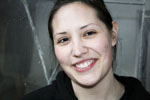Overview of the AAA schools
Ryan Beltram | The School of Architecture & Allied Arts at the University of Oregon is a learning community of teachers and students.
Artist Theresa Sterner profile
Kelli Curtis | Following a Bachelor of Fine Arts student as she readies her installation for a final critique
Architecture student reviews
Topher Vollmer | Instead of spending their time poring through textbooks, architecture students work to prepare for reviews.
Critique Week
A look into the schools of Architecture and Allied Arts
The art of review
In the world of college architecture the review process takes the place of tests and grades.
By Topher VollmerIn an academic world dominated by GPA's and test scores, the School of Architecture and Allied Arts does things a little bit differently. Instead of papers and exams, the architecture students create models and present their work to be reviewed in shows that generally occur at the end of each term.
The reviews build on each other. Each time a student is reviewed, he or she will be expected to take into account the criticisms received and improve for the next presentation. Improvement from installation to installation goes a long way to a student receiving a passing grade in the studio class. There are no letter grades. If you show improvement, you pass and move on.
"You just try to be better then your last piece every time," University graduate student Scott Nieradka said. Scott is in the Art program at the University, but his class schedule includes a few architecture studios.
Such an unusual system means that both the instructors and their students have a collegiate experience that would be quite unrecognizable to a business, biology or philosophy student. Instead of spending their time poring through textbooks, architecture students spend their time Dumpster diving for building materials and constructing models.
The review is also unique in that for most projects, especially at the lower levels, there is no real right or wrong answer. Certain goals must be accomplished in a model, of course, but just as important is the clarity with which the model is presented and explained.
"Anybody can design a building. It's about whether you can present it graphically," University graduate student and studio assistant Britni Jessup said.
|
 |
Jessup is one of the reviewers for some of the beginner-lever studio classes. Jessup, along with fellow graduate student and GTF Sam Rusek, reviewed the projects for the Architecture 283 studio class; one of the first studio classes in the program.
Both reviewers agreed that, especially at the beginner levels, presenting models graphically is just as important as the effectiveness of the actual model designed. If the presentation of the model can be understood easily during the review and the finished product resembles the desired ideas of the creator, then Jessup and Rusek will generally have good things to say in their critiques.
This graphic presentation often has as much to do with the drawing and attention to detail in the original sketches as it does to the finished model. One of the most common problems with presentation that both Jessup and Rusek found had to do with the line weight of the drawings that accompanied the models. The width and darkness of a line in the drawing of a model might seem like a minor detail, but it's the small details can hurt a project most. It is common for projects to have small presentation errors that catch the attention of the reviewers and distract them from the bigger goals of the piece.
"As a student you want to create a project that allows you to direct the reviewer towards the ideas you want to focus on," Rusek said.
If presentation errors distract the reviewer from the bigger ideas and strengths of a model, then the hard work that goes into those aspects could easily be overlooked.
After the shows are finished, each reviewer will write a report that details certain patterns he or she saw throughout the class as a whole and in relation to specific individuals' presentations. These reports are then returned to the studio professor with whom the students have been working throughout the term. The reviewers do not assign any kind of grade; they simply report their observations. The student will then go for a one-on-one exit interview with the studio professor. In this interview, the student again presents the project and defends it. It is then up to the professor to decide whether the student has improved and whether he or she will pass the class. Again, no grades are awarded, but if the presentation is a success the student will move on to more difficult studio classes.
The review system can be strenuous. Students often spend a few days with little or no sleep as they prepare their final models and presentations. Some students have even been known to fall asleep next to their models during their final showings after pulling multiple all-nighters in order to finish the work. The review system allows the school to assess students while also helping to nurture and grow the creativity that is so important in architecture and any artistic field.



